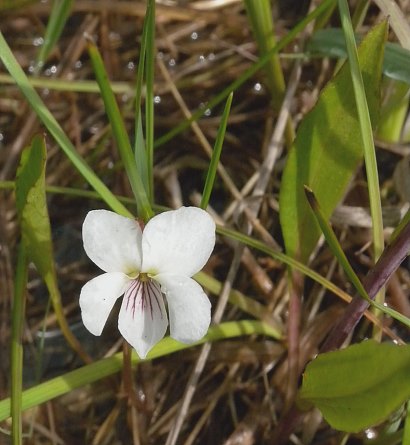
The blooming period occurs during late spring for about 3 weeks. Fertilized flowers are replaced by seed capsules about 1/3" long; these capsules are light green and ellipsoid-oblongoid in shape. Later in the summer, cleistogamous (self-fertile) flowers are produced from slender stolons. These cleistogamous flowers lack petals and remain inconspicuous. Each seed capsule eventually splits open into 3 parts, ejecting the small dark brown seeds. The root system consists of a short narrow crown with fibrous roots.
Cultivation: The preference is full sun, wet to moist conditions, and an acidic soil containing sand, gravel, or peat. Lance-Leaved Violet tolerates standing water to a greater extent than other violets.
Range & Habitat: The native Lance-Leaved Violet is occasional in northern Illinois, while in the rest of the state it is rare or absent (see Distribution Map). Habitats include wet to moist sand prairies, sandy swales, soggy shrub prairies, moist sandy savannas, bogs, gravelly areas along streams or lakes, and flood-prone areas of sandy paths. In Illinois, this violet is typically found in high quality natural areas where there is limited competition from other plants.

Faunal Associations: The flowers of violets are visited by bumblebees, mason bees (Osmia spp.), long-horned bees (Synhalonia spp.), the Violet Andrenid bee (Andrena violae), the Giant bee-fly (Bombylius major), small butterflies, and skippers. These floral visitors seek nectar or pollen. Other insects feed on the foliage, plant juices, and other parts of violets. The caterpillars of several Fritillary butterflies feed on violets: Boloria bellona (Meadow Fritillary), Boloria selene myrina (Silver-Bordered Fritillary), Euptoieta claudia (Variegated Fritillary), Speyeria aphrodite (Aphrodite Fritillary), Speyeria atlantis (Atlantis Fritillary), Speyeria cybele (Great Spangled Fritillary), and Speyeria idalia (Regal Fritillary). Other insect feeders include caterpillars of the moths Elaphria grata (Grateful Midget) and Eubaphe mendica (The Beggar), Aulacorthum circumflexum (Crescent-Marked Lily Aphid) and Neotoxoptera violae (Violet Aphid), the larvae of Ametastegia pallipes (Viola Sawfly), and the thrips Odontothrips pictipennis. Among vertebrate animals, the seeds of violets are eaten by such birds as the Ruffed Grouse, Wild Turkey, Bobwhite, and Mourning Dove. The White-Footed Mouse and probably other small rodents also eat small amounts of the seeds. The foliage is browsed to a limited extent by the Cottontail Rabbit and Wood Turtle (Clemmys insculpta).
Photographic Location: Wet area of a sandy path that meandered through open shrub prairie at Kitty Todd Nature Preserve in NW Ohio.
Comments: This interesting violet has a distinctive appearance because of its narrow leaves. There are two subspecies of Lance-Leaved Violet: Viola lanceolata lanceolata (as photographed here) and Viola lanceolata vittata. The typical subspecies has leaf blades that are 3-5 times as long as they are across, while the latter subspecies has leaf blades that are 6-15 times as long as they are across. In Illinois, the typical subspecies is the more common of the two.